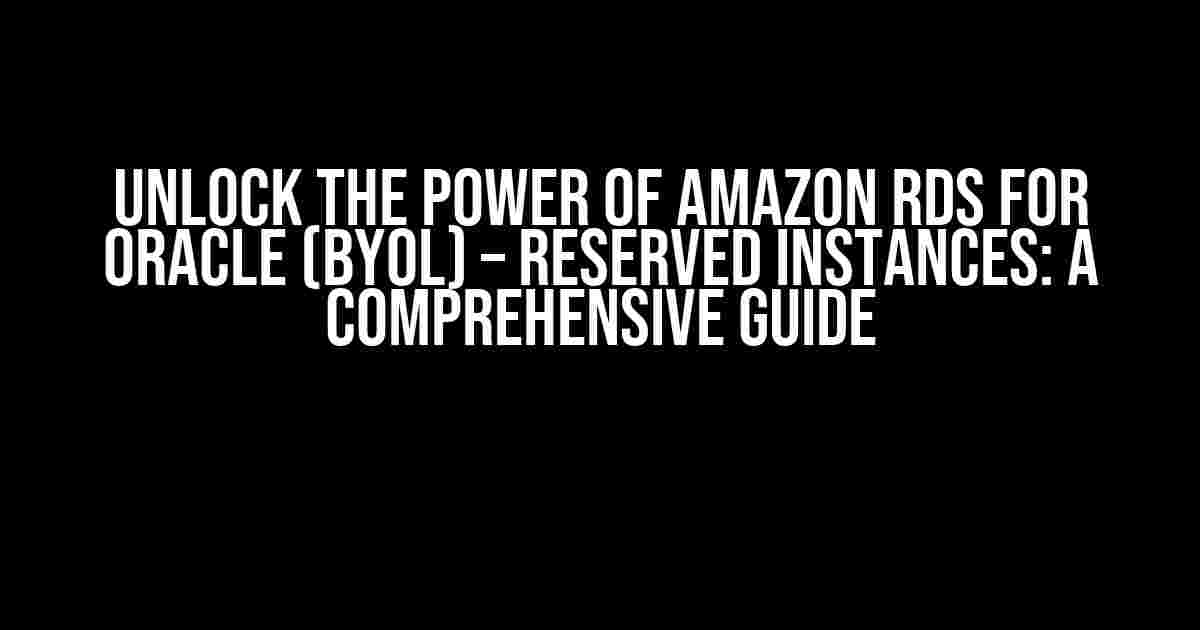Are you tired of feeling locked into expensive and inflexible database management systems? Do you want to take advantage of the scalability and reliability of the Amazon Web Services (AWS) cloud, while still using your trusty Oracle database? Look no further than Amazon RDS for Oracle (BYOL) – Reserved Instances! In this article, we’ll dive deep into the benefits and setup process of this powerful tool, so you can start reaping the rewards of a more efficient and cost-effective database management system.
What is Amazon RDS for Oracle (BYOL)?
Amazon RDS for Oracle (BYOL) stands for “Bring Your Own License”, which means you can use your existing Oracle licenses to run Oracle databases on AWS. This allows you to take advantage of the scalability, reliability, and security of the AWS cloud, while still using your familiar Oracle database management system. With RDS for Oracle (BYOL), you can choose from a variety of instance types and configurations to meet your specific needs, and only pay for what you use.
Benefits of Amazon RDS for Oracle (BYOL) – Reserved Instances
So, why choose Amazon RDS for Oracle (BYOL) – Reserved Instances? Here are just a few of the benefits:
- Cost Savings**: With Reserved Instances, you can save up to 63% compared to On-Demand pricing, making it a more cost-effective option for long-term database management.
- Scalability**: RDS for Oracle (BYOL) allows you to scale your database up or down to meet changing demand, without having to worry about provisioning or managing new hardware.
- Reliability**: With AWS, you can take advantage of built-in high availability and failover capabilities, ensuring your database is always available and accessible.
- Security**: RDS for Oracle (BYOL) provides enterprise-grade security features, including encryption at rest and in transit, to protect your sensitive data.
- Support**: With AWS, you get access to 24/7 support, including real-time monitoring and troubleshooting, to help you resolve issues quickly and efficiently.
Setting up Amazon RDS for Oracle (BYOL) – Reserved Instances
Now that you know the benefits, let’s dive into the setup process. Don’t worry, it’s easier than you think!
Step 1: Create an RDS Instance
First, log in to your AWS Management Console and navigate to the RDS dashboard. Click on “Instances” and then “Create instance”. Choose “Oracle” as the database engine and select the instance type and configuration that meets your needs.
aws rds create-db-instance \
--db-instance-identifier my-oracle-instance \
--db-instance-class db.r5.large \
--engine oracle-ee \
--license-model bring-your-own-license \
--master-user-name my-master-username \
--master-user-password my-master-user-password
Step 2: Configure Your RDS Instance
Next, configure your RDS instance by specifying the details of your Oracle database. This includes the Oracle System Identifier (SID), database name, and administrator credentials.
aws rds modify-db-instance \
--db-instance-identifier my-oracle-instance \
--oracle-settings file://oracle-settings.json
Step 3: Create a Reserved Instance
To take advantage of the cost savings of Reserved Instances, create a reservation for your RDS instance.
aws rds purchase-reserved-db-instances-offering \
--reserved-db-instances-offering-id d6717a41-3a4f-44a2-9d3e-EXAMPLE \
--db-instance-count 1
Step 4: Monitor and Optimize Your RDS Instance
Finally, monitor and optimize your RDS instance to ensure it’s running efficiently and effectively. Use the AWS Management Console or APIs to track performance metrics, such as CPU utilization and storage usage.
| Metric | Description |
|---|---|
| CPU Utilization | The percentage of CPU usage for your RDS instance. |
| Storage Usage | The amount of storage used by your RDS instance. |
| Memory Usage | The amount of memory used by your RDS instance. |
Troubleshooting Common Issues
Like with any new system, you may encounter some issues when setting up Amazon RDS for Oracle (BYOL) – Reserved Instances. Here are some common issues and their solutions:
Issue 1: Oracle License Validation
If you encounter issues with Oracle license validation, check that your Oracle license is valid and up-to-date. Make sure you have the correct license key and that it’s correctly configured on your RDS instance.
Issue 2: Database Performance
If you notice poor database performance, check your RDS instance configuration and ensure it’s optimized for your workload. You can also use AWS tools, such as Amazon CloudWatch, to monitor and troubleshoot performance issues.
Issue 3: Security Configuration
If you encounter security configuration issues, ensure that your RDS instance is correctly configured for security. Check your VPC security groups, network ACLs, and database access controls to ensure they’re correctly configured.
Conclusion
In conclusion, Amazon RDS for Oracle (BYOL) – Reserved Instances is a powerful tool for managing your Oracle database in the cloud. With its cost-effective pricing, scalability, reliability, and security features, it’s an attractive option for businesses of all sizes. By following the steps outlined in this article, you can set up and optimize your RDS instance, and start reaping the rewards of a more efficient and cost-effective database management system.
Remember, with AWS, you have access to a range of tools and resources to help you succeed. Take advantage of AWS support, documentation, and community resources to get the most out of your RDS instance.
So, what are you waiting for? Get started with Amazon RDS for Oracle (BYOL) – Reserved Instances today and unlock the power of the AWS cloud for your business!
Here are 5 Questions and Answers about “Amazon RDS for Oracle (BYOL) – Reserved Instances” in a creative voice and tone:
Frequently Asked Question
Get the scoop on Amazon RDS for Oracle (BYOL) – Reserved Instances with our FAQs!
What is Amazon RDS for Oracle (BYOL) – Reserved Instances?
Amazon RDS for Oracle (BYOL) – Reserved Instances is a cost-effective way to run Oracle databases in the cloud. BYOL stands for “Bring Your Own License,” which means you can use your existing Oracle licenses with Amazon RDS. Reserved Instances provide a discounted hourly rate compared to On-Demand Instances, making it a great option for long-term workloads.
How do I purchase Amazon RDS for Oracle (BYOL) – Reserved Instances?
You can purchase Amazon RDS for Oracle (BYOL) – Reserved Instances through the AWS Management Console or AWS CLI. Simply select the instance type, term, and payment option that best fits your needs, and AWS will provide the reserved capacity.
What are the benefits of using Amazon RDS for Oracle (BYOL) – Reserved Instances?
Using Amazon RDS for Oracle (BYOL) – Reserved Instances provides a significant discount compared to On-Demand Instances, helping you reduce your Oracle database costs. Additionally, Reserved Instances provide a capacity reservation, ensuring that you have access to the compute resources you need, when you need them.
Can I change or cancel my Amazon RDS for Oracle (BYOL) – Reserved Instances?
Yes, you can modify or cancel your Amazon RDS for Oracle (BYOL) – Reserved Instances, but there may be certain restrictions and fees associated with doing so. Be sure to review the terms and conditions before making any changes to your reservation.
How do I track my Amazon RDS for Oracle (BYOL) – Reserved Instances usage?
You can track your Amazon RDS for Oracle (BYOL) – Reserved Instances usage through the AWS Management Console, AWS CLI, or AWS Cost Explorer. These tools provide detailed reports and metrics to help you optimize your Reserved Instance usage and costs.



